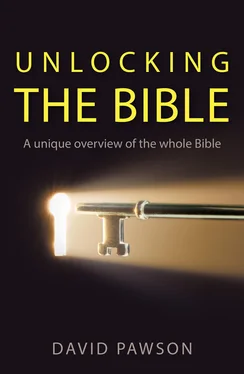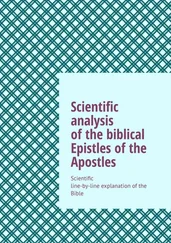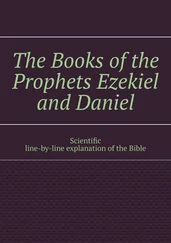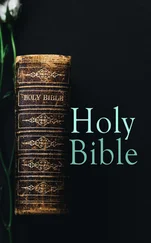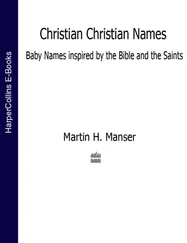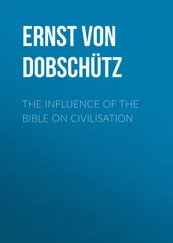The second theory is that they went straight across through the Mitler Pass to Kadesh. But there was a line of fortresses (where the Suez Canal is today) built across there, against any invasion from the east. So the Israelites would have had to get through that line of fortresses. They were not armed and able to fight, so this route is very unlikely also.
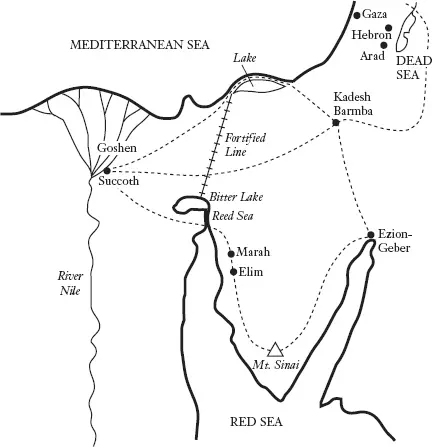
The third possibility was the southern route down to Mount Sinai, where Moses had been a shepherd for 40 years. This is the most likely, for Moses knew this country. The location of Mount Sinai is uncertain, but all the tradition in the Middle East puts Sinai in the south. The Israelites left Goshen and came south. Pharaoh would only let them go into the desert, thinking that he could always bring them back from there. Having camped, they were hidden from the Egyptians by a cloud God had sent.
As regards the actual crossing of the sea, the Bible does not say that God divided the Red Sea, but that he sent an east wind which divided the water. But how could an east wind divide a sea?
If we were to examine the area in detail we would see that years ago the Great Bitter Lakes were actually joined up to what we call the Red Sea (see diagram below). They were joined up by a shallow, marshy channel called the ‘Reed Sea’ and in fact the Hebrew suggests the ‘Reed Sea’ is a more likely name than the ‘Red Sea’. The fortified line came right down to the Bitter Lake.
If this was where the Hebrews crossed, there are two natural forces which could have divided the sea. A strong east wind could drive the water to the west end of the Great Bitter Lake, an ebb tide also pulling it south.
This does not explain the miracle at all. How did the east wind just happen to come at the right time? In looking at it in such a down-to-earth way, we are not trying to explain away the miracle. Rather we are showing that it is a miracle of ‘coincidence’. In fact, the Bible tells us that there is no such thing as ‘coincidence’, but only ‘providence’.
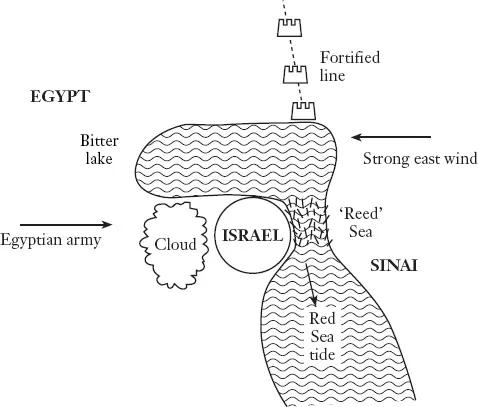
The most striking fact about this crossing of the Red Sea or Reed Sea is that it happened on the third day after the Passover lamb was killed. The Israelites’ liberation came on the third day after the Passover lamb. Furthermore, the book of Exodus tells us the very hour when the Passover lamb had to be slaughtered: 3.00 p.m. On the third day after that the Israelites finally escape. They are free of Pharaoh and will never see him again. We will note later some parallels with events in the New Testament.
6. Provided and protected
The desert region over which the Israelites travelled was unable to support human life. It was not the ideal place to take 2.5 million people plus animals.
There were both external and internal problems for Moses, therefore, the most basic being the physical need for food and water. Every morning God provided food for them. They found it lying on the ground when they awoke. It was known as ‘What is it?’ in Hebrew – Manna. Every day there were 900 tons of it. It was literally bread from heaven, a theme revisited later in the Bible.
Though living comfortably on manna, the Israelites complained that they were not getting any meat. They had been used to a high-protein diet in Egypt. So God sent a flock of quails, so many that they lay 1.5 metres deep on the desert floor. The people ate quails until they were sick of them!
They also had a problem with water. The first oasis they came to was Marah. Although the place provided water, it was undrinkable – until it became fresh through a miracle. The next place, Elim, had fresh water from the start. The quantities required were considerable – at least 2 million gallons a day would be needed for that number of animals and people. Later they would get water from rock reservoirs. Perhaps one of the biggest miracles of their providential journey was that their sandals never wore out. Rocks even today wreck rubber tyres on vehicles, yet these sandals lasted 40 years!
Moses also faced internal difficulties. Given the enormous numbers, it is no wonder that one of the biggest problems Moses had was judging disputes between the people. We are told that this could go on all day, to the point where Moses became exhausted. It needed his father-in-law Jethro to suggest a delegation of responsibility, whereby Moses appointed 70 elders to assist in the work.
Chapters 19–40
After the narrative of the escape from Egypt, the second part of Exodus turns more towards legislation, the commandments God gave his people, telling them how they were to live, and the covenant he made with them.
7. Commandments and covenant
There are three ‘legal’ collections in the second half of Exodus. The best known is the ‘Ten Commandments’ (or decalogue, which means ‘10 words’), written with God’s finger on two tablets of stone. (Most modern pictures of the event depict Moses returning from Mount Sinai with the Ten Commandments split between the two tablets, five on one and five on the other, but actually all 10 were on each stone.) This was a legal contract, in keeping with similar treaties agreed at that time. A conquering king might make a treaty with a vanquished nation, for example. Each party would have a copy. In the case of the Ten Commandments, one copy was God’s and one copy was the people’s. This treaty was special, however, known in the Bible as a ‘covenant’. A covenant was not a bargain between two parties but a contract written by God which could be either accepted or rejected by the people.
The Ten Commandments formed the first legal collection and this was followed by what is known as the ‘Book of the Covenant’, which can be found in Exodus 20:23–23:33. This deals with laws relating to community life. The third collection is the book of laws in Chapters 25–31, which centre on the worshipping life of Israel and are concerned with the place of worship and those conducting worship. Overlap and expansion of these laws is found in Deuteronomy. Thus there are not just Ten Commandments, but a total of 613 rules and regulations about the way to live right before God.
It is crucial to underline the importance of the context of the laws in Exodus. The Ten Commandments and the Book of the Covenant are sandwiched between two links which refer to the past and the future.
1 In 20:2 God says, ‘I am the LORD your God, who brought you out of Egypt, out of the land of slavery.’
2 In 23:20–33 God assures the people of his presence in the future and of the provision of land, providing they keep to his ways.
The first text refers back to Egypt and the second passage focuses on entering Canaan in the future. The context tells us that these laws from God are for people who have experienced his past and are expecting his future and who will therefore be able to live in his present.
King Alfred based the British legal system on the Ten Commandments, but it is hard to see how people can understand them if they have not experienced redemption. They must be seen in the proper context.
THE TEN COMMANDMENTS
A closer look at the Ten Commandments and the accompanying legislation reveals three basic principles which are enshrined there. First is the principle of respect. All the Ten Commandments are based on this – respect for God, respect for his name, respect for his day, respect for people, respect for family life, respect for life itself, respect for marriage, respect for people’s property, respect for people’s reputation.
Читать дальше
